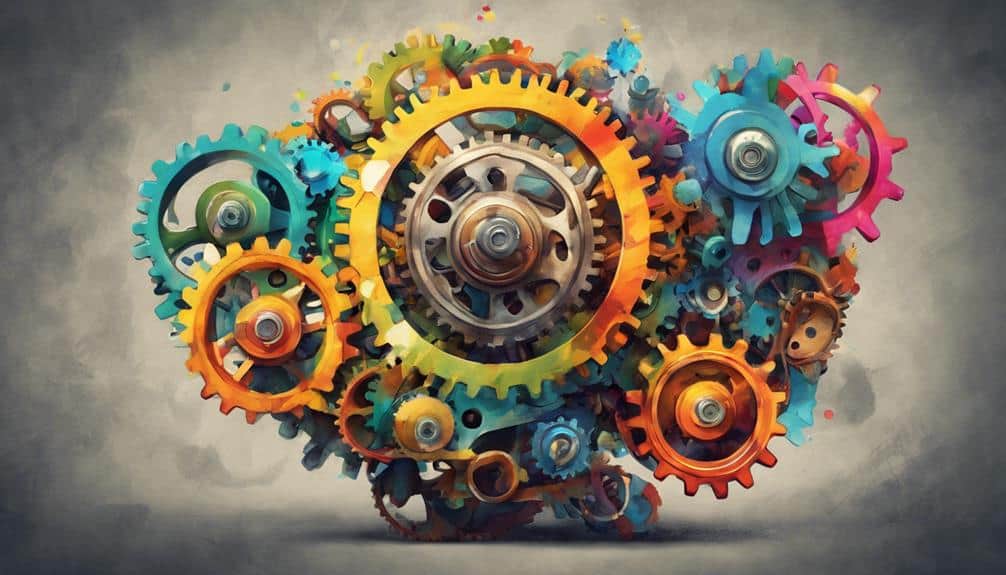Adhd Driven by a Motor
As a child, I was often likened to a ball bouncing uncontrollably in a room, with my energy seemingly endless. This metaphor of being 'driven by a motor' vividly captures the essence of hyperactivity in ADHD.
But what lies beneath this surface level observation? How does this motor-like behavior impact daily life and relationships, and what strategies can be employed to navigate these challenges effectively?
Let's explore the intricate connection between ADHD and its motor component, delving into the nuances that shape the experiences of individuals with this condition.
Key Takeaways
- Hyperactivity and impulsivity in ADHD are motor-driven behaviors.
- Challenges in sustained attention and stillness stem from motor components.
- Managing ADHD involves structured routines, physical activity breaks, and sensory tools.
- ADHD individuals exhibit unique qualities like creativity, passion, and resilience.
Understanding Motor Component in ADHD

Understanding the motor component in ADHD is essential for grasping the intricate behavioral patterns exhibited by individuals affected by this neurodevelopmental disorder. When considering ADHD symptoms, it becomes evident that the hyperactivity and impulsivity often seen in those diagnosed with ADHD are driven by a motor.
This motoric component can lead to behaviors such as leaving one's seat in situations where remaining seated is expected, running about or climbing inappropriately, and struggling to engage in leisure activities quietly. Additionally, individuals with ADHD may find it challenging to engage in tasks that require sustained attention, as they're often easily distracted due to this heightened motor activity.
Recognizing the role of this motor component is critical for understanding why individuals with ADHD may struggle with behaviors that involve stillness and calmness, impacting their daily functioning and social interactions significantly.
Impact of Hyperactivity on ADHD

Hyperactivity in individuals with ADHD manifests as excessive motor activity, restlessness, and a persistent struggle to settle down. This heightened level of motor activity often leads to challenges in various aspects of life.
Here are some key impacts of hyperactivity on individuals with ADHD:
- Social Interactions: Constant movement and excessive talking can make it difficult for individuals with ADHD to engage in social interactions effectively.
- Academic Performance: Restlessness and fidgeting can interfere with concentration and focus in academic settings, affecting learning and performance.
- Daily Functioning: The struggle to settle down and constant need for movement can impede daily tasks and routines, impacting overall functioning.
- Energy Bursts: Sudden bursts of energy can be disruptive and make it hard to maintain focus on tasks for extended periods.
- Focus: Difficulty in maintaining stillness and staying on task can hinder the ability to concentrate and complete activities efficiently.
These challenges highlight the significant impact hyperactivity can have on individuals with ADHD across various aspects of their lives.
Unpacking Impulsivity in ADHD

The constant impulsivity seen in individuals with ADHD can present significant challenges in various aspects of their lives, impacting decision-making and social interactions. Impulsivity, a core symptom of ADHD, involves making hasty decisions without fully considering the consequences. This impulsivity can manifest in both children and adults with ADHD, leading to difficulties in school, work settings, and relationships. Impulsive behaviors may include interruptions, blurting out answers, or taking risks without evaluating the potential outcomes. These actions can disrupt daily functioning and create social challenges, requiring tailored interventions for effective management.
Understanding the role of impulsivity in ADHD is essential for developing strategies to address its impact on individuals' lives. By recognizing how impulsivity influences decision-making processes and social interactions, healthcare professionals can work towards implementing interventions that support individuals with ADHD in managing their impulsive tendencies. Tailored interventions focusing on impulse control, decision-making skills, and social strategies can help individuals with ADHD navigate daily challenges and improve their overall quality of life.
Strategies for Managing Motor-Driven ADHD

Children with motor-driven ADHD often exhibit constant movement, restlessness, and fidgeting as a core manifestation of their hyperactivity. When managing motor-driven ADHD in children, it's important to implement strategies that cater to their specific needs. Here are some effective approaches:
- Structured routines: Establishing predictable schedules can help children with ADHD navigate their day more smoothly.
- Physical activity breaks: Incorporating short breaks for movement can assist in releasing excess energy and improving focus.
- Sensory tools: Providing tools like fidget toys or stress balls can offer sensory stimulation, aiding in self-regulation.
- Clear expectations: Clearly outlining tasks and expectations can help children with ADHD stay on track and reduce anxiety.
- Positive reinforcement: Rewarding desired behaviors can motivate children with motor-driven ADHD to engage in tasks that require sustained mental effort.
Celebrating Unique Qualities of ADHD Individuals

Acknowledging and celebrating the unique qualities of individuals with ADHD goes beyond recognizing their challenges and embraces their creativity, excitement, and resilience. ADHD individuals often exhibit remarkable creativity, thinking outside the box, and approaching problems in unconventional ways. Their excitement and enthusiasm can be infectious, bringing energy and passion to tasks and projects. Despite facing difficulties in settling down quickly and finding it challenging to be quiet, individuals with ADHD demonstrate remarkable resilience in overcoming obstacles and persevering through adversity.
Understanding the meaning behind ADHD symptoms is important in providing the necessary support and empowerment for individuals with ADHD. By recognizing and celebrating their unique qualities, we can help promote positive self-esteem and self-acceptance. Creating an environment that values and nurtures their strengths can empower individuals with ADHD to thrive and reach their full potential. By embracing the creativity, excitement, and resilience of ADHD individuals, we can foster a culture of inclusivity and appreciation for diversity in neurodiversity.
Frequently Asked Questions
What Does It Mean to Be Driven by a Motor?
To be "driven by a motor" means experiencing hyper focus, racing thoughts, impulsive actions, restless energy, fast reactions, constant movement, intense emotions, rapid speech, overwhelmed mind, and high energy. It signifies a state of heightened activity and intensity.
What Often Acts as if Driven by a Motor?
I often find myself displaying restless energy, hyperactive behavior, racing thoughts, impulsive actions, fidgety movements, quick decisions, unpredictable movements, energetic bursts, rapid speech, and constant motion. This constant activity can be challenging to manage.
Do People With ADHD Struggle With Motor Skills?
Yes, individuals with ADHD often struggle with motor skills, including motor coordination, fine motor skills, and motor control. Hyperactivity challenges, impulsivity effects, and difficulties with motor planning can impact daily tasks and movement development.
What Are the Dark Side of Adhd?
The dark side of ADHD involves impulsivity consequences, emotional dysregulation, relationship challenges, cognitive overload, time management difficulties, medication side effects, executive function impairments, sleep disturbances, impact on self-esteem, and the necessity of developing effective coping mechanisms.
Conclusion
To sum up, overseeing the motor-driven aspects of ADHD is vital for aiding individuals in reaching their full potential.
For instance, I recently collaborated with a young boy who struggled with hyperactivity and impulsivity. By integrating structured activities, clear rules, and social skill development into his daily routine, we observed a significant improvement in his behavior and overall well-being.
It's important to acknowledge the unique qualities of individuals with ADHD and provide them with the support they need to thrive.







